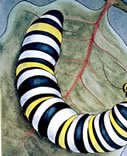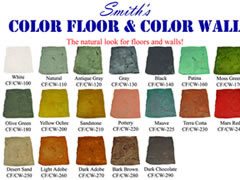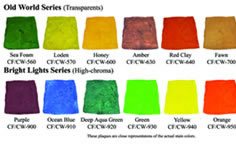- Coloring Supplies
- Concrete Stains
- Concrete Dyes
- Color Hardener
- Integral Color
- Resurfacing & Overlays
- Concrete Coatings
- Concrete Overlay Supplies
- Concrete Resurfacer
- Vertical Concrete Overlays
- Terrazzo Flooring
- Concrete Countertops
- Countertop Mixes & Supplies
- Texturing & Patterns
- Concrete Stamps
- Concrete Stencils
- Concrete Engraving
- Forms & Molds
- Concrete Forms
- Concrete Molds
- Step Forms
- Concrete Polishing
- Polishing Equipment
- Concrete Densifiers
- Tools & Equipment
- Surface Preparation
- Concrete Tools
- Concrete Power Tools
- Concrete Pumps
- Protection & Repair
- Concrete Sealer
- Cleaning Concrete
- Concrete Repair
- Curing Concrete
- Vapor Barriers
- Foundation Waterproofing
- Concrete Mix
- Concrete Admixtures
- GFRC Mixes & Supplies
Water-Based Concrete Stain from Smith Paint
Giving Concrete Contractors a Full Color PaletteFind Water-Based Concrete Stain Suppliers
Water-based concrete stains allow concrete artists to push the envelope when it comes to color. When concrete artisans expressed an interest in paints, Chuck Brunner, the owner of Smith Paint Products, Harrisburg, PA, found out what they wanted to achieve and then found the formula that worked. His goal was to reduce opacity, increase penetration and adhesion and create UV resistant color. With a new formula, Brunner launched Smith's Color Floor and Color Wall. He recently added, the Old World Series that offers additional options of transparent color, and metallic.
Concrete Artisans
It was Gerald Taylor, Images in Concrete, El Dorado, AR, who approached Brunner several years ago asking for a transparent stain for concrete floors. Taylor and Steven Ochs, a professor of art at Southern Arkansas University, Magnolia who joined with Gerald Taylor, install site-specific public work. Their signature style includes engraving a pictorial design and coloring it with stain. Och's lays out the design and Taylor, using an angle grinder, engraves the image into the concrete. Then Ochs blocks in basic colors using thin washes of the paint-stain. In advancing degrees of complexity he uses stain from the can or mixes color to mottle, create a shadow or highlight an area. Ochs uses anything from a paintbrush to an airbrush to achieve the desired look. He recommends getting a book on watercolor painting. He says that when you use the transparent stains, the watercolor techniques apply to concrete. Ochs says, "Smith paints are durable. They are so smooth to use, and they penetrate the concrete almost a 32nd of an inch-enhancing durability."
When asked about traffic and wear, Ochs says that the paint or stain layer is not the wearing surface. The pigmented picture-layer achieves the desired aesthetics. Sealers applied afterwards form the wearing surface. All work must be sealed with an acrylic sealer and in high traffic areas, renewed when necessary. Smiths Color Floor is compatible with a variety of sealers including water- and solvent-based urethanes as well as two component epoxies.
Taylor and Ochs frequently meet with community interest groups to decide the project design and the materials. Ochs designs often utilize water-based stain. He appreciates the wide color range that suits simple or intricate plans.
Horizontal and Vertical Stain Application
Horizontal applications are diverse including interior and exterior floors, countertops, pool-decks, patios, and driveways. To apply the stain, use a high volume low-pressure unit (HVLP), a production gun, or a pump sprayer. For best results, make thin applications and allow the absorbent surface to draw the stain. To do detail work you may be artful with a paintbrush, or use an airbrush. If you choose a thick roller, the application produces a monotone or painted look and diminishes transparency.
Vertical stain applications are good on stucco or concrete, for interior or exterior walls, sound walls or artificial rockwork. Smiths Color Wall Stains are best applied to large areas via an airless paint sprayer using 65-70 pounds of pressure and a #13 tip. Use a pump sprayer, sea sponge or paintbrush for touchup or smaller areas.
Problem Prevention
The greatest problems arise when dust or dirt prevents good adhesion and penetration of the materials. As with any application on concrete, make sure the surface is clean anddry. Remove loose particles, and efflorescence. Acid washing improves adhesion by providing a clean open surface for water-based materials to penetrate. Aclean surface is very important with water-based coatings, as the particle size of molecules is larger than in solvent-based materials. Particle size affects the amount of penetration. The ideal temperature for application is 70 degrees, but the range can be as low as 45 and as much as 90 degrees. Humidity slows drying time and its best to not apply paint in direct sunlight if temperatures are extremely high.
Brunner says that when it comes to paint there is always new technology and ways to make a better product. The important factors in making paints, stain and dye for concreteare the choices in resin material, the size of the pigment granules, and the medium that carries the pigment. These factors affect adhesion and penetration into the concrete. Smith Paints makes sure the resin is compatible with an alkali environment and UV light resistant so that colors do not fade. They chose water based resin formulations because they are safer and less toxic when compared to solvent based products. Their pigments are specially ground to appropriate size for a concrete application. The ingredients are as chemical resistant as possible. The products are breathable so moisture can pass through the film. And the formulations allow repeated application and color mixing just as an artist would on their palette.
For more information: Smith Paints (www.smithpaints.com) or call (800) 466-8781
Find Water-Bases Concrete Stain Suppliers
Jeanne Fields is the owner of Fields Marketing, which provides marketing services for contractors and manufacturers in the decorative concrete industry.










